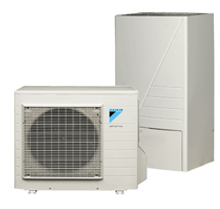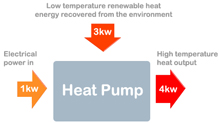Grants available
Did you know you can get funding for existing energy saving measures and new energy saving improvements? We can advise you on what you're entitled to.
Energy saving tips
Join our newsletter to receive news and special offers direct to your inbox.
Air Source Heat Pumps
Renewable energy installations are becoming increasingly widespread and a key part of this is down to Air Source Heat Pump systems - which aren't as complex and expensive as they sound.
What is a heat pump?
It all starts with the sun. The sun warms up our atmosphere and the outer layer of the earth's crust. In one year the energy sent to the earth by the sun is 50 times higher than the total consumption of energy on our planet. This makes the sun a vast and inexhaustible source of energy. On sunny days you can feel the thermal energy from the sun on your skin. But actually, there is always lots of thermal energy in the air, even on cold winter days or even at night. And not only in Florida or the south of Spain, but also in countries like Sweden or Norway where thousands of houses already have heat pumps.
How do heat pumps work?
A heat pump only needs a heat source (the outside air), two heat exchangers (one to absorb and another one to release heat) and a relatively small amount of drive energy to keep the system going. A heat pump extracts thermal energy from the environment. In the case of Daikin Altherma the source is the outside air. The pump extracts the energy at a certain temperature, increases that temperature and then releases it into a medium which in the Daikin Altherma system is the water running to your low temperature radiators, under floor heating system or fan coil units. Between those two media the heat is moved by means of a working fluid.
Compressor - the essence of heat pumps
As the working fluid passes through the evaporator and extracts heat from the air, it turns into a gas. This is where the compressor comes in. When you compress a gas the temperature rises. (for example if you inflate the tyre of your bicycle, you can feel the air inside warming up through the rubber). Inside your house the second heat exchange takes place when the compressed gas enters the condenser, a surface which is colder than the gas itself. Finally, the gas condenses and releases its heat - this heat then warms up your house.


- Click here to see our manufacturers
Air Source Heat Pump video